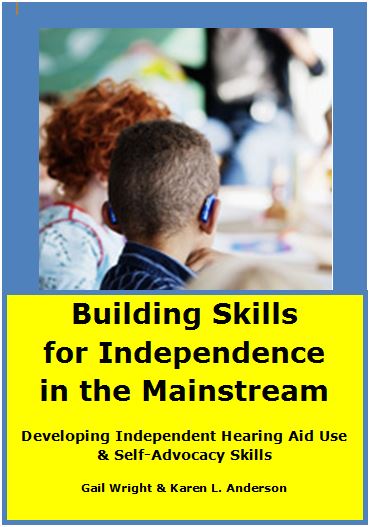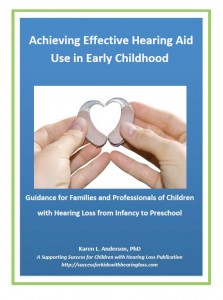Related Products
For Parents
Related Teacher Tools Takeout Items
Technology Monitoring Is Necessary For Hearing Device Users
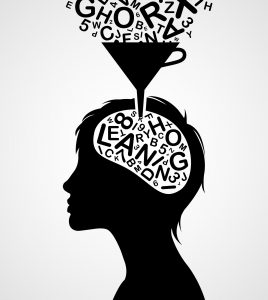 The job of hearing devices is to improve the audibility of speech, allowing students to perceive much more of verbal instruction and all other spoken communication more fully. By funneling more audible speech information into the brain, the student is able to access more of the curriculum. For our hard of hearing students, hearing devices can be considered the gateway to their educational and social success. For the impact of hearing loss to be minimized optimally, students who are hard of hearing need well fit hearing aids or implants, the devices need to function appropriately, and the student needs to be willing to use the devices in school, and preferably all waking hours. Each of these can be a significant challenge that is a barrier to student success.
The job of hearing devices is to improve the audibility of speech, allowing students to perceive much more of verbal instruction and all other spoken communication more fully. By funneling more audible speech information into the brain, the student is able to access more of the curriculum. For our hard of hearing students, hearing devices can be considered the gateway to their educational and social success. For the impact of hearing loss to be minimized optimally, students who are hard of hearing need well fit hearing aids or implants, the devices need to function appropriately, and the student needs to be willing to use the devices in school, and preferably all waking hours. Each of these can be a significant challenge that is a barrier to student success.
Challenge 1: Well-Fit Hearing Devices
One of the results of the 2015 Outcomes of Children with Hearing Loss Study1 was that well-fit HAs reduce risk and provides some degree of protection against language delay. Greater aided audibility is associated with better language outcomes in preschool. HAs are well-fit when speech is made as audible as possible by closely matching gain to prescriptive targets, the latter of which is dependent upon the child’s degree and configuration of HL. 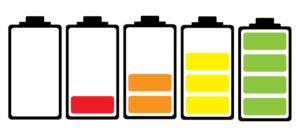 Another finding of this broad study was that 31% of children who are hard of hearing had hearing aids that were not fit to optimize speech perception. Just because a child is wearing hearing aids does not mean that he is perceiving speech as optimally as possible. Results indicated that optimized audibility made positive contributions to children’s language and auditory development, even for the children with mild hearing loss. Children receiving the most benefit from their HAs (i.e., greatest aided audibility after controlling for the influence of unaided hearing) demonstrated a positive language growth pattern, showing steady improvement in standard scores from age 2 to 6 years. In contrast, children receiving the lowest benefit from hearing aids showed no change in standard scores over the same time period. By 6 years of age, there was a cumulative difference between these groups of two thirds of a standard deviation. In addition, aided audibility was positively associated with multiple measures of word recognition in quiet from ages 2 to 6 years and in noise for 7- to 9-year-olds. Children with greater aided audibility had better auditory development outcomes and speech recognition abilities than children with lower aided audibility across a wide range of ages and outcome measures. These conclusions support the inclusion of aided audibility in the model as a factor that moderates the impact of HL on children’s outcomes.
Another finding of this broad study was that 31% of children who are hard of hearing had hearing aids that were not fit to optimize speech perception. Just because a child is wearing hearing aids does not mean that he is perceiving speech as optimally as possible. Results indicated that optimized audibility made positive contributions to children’s language and auditory development, even for the children with mild hearing loss. Children receiving the most benefit from their HAs (i.e., greatest aided audibility after controlling for the influence of unaided hearing) demonstrated a positive language growth pattern, showing steady improvement in standard scores from age 2 to 6 years. In contrast, children receiving the lowest benefit from hearing aids showed no change in standard scores over the same time period. By 6 years of age, there was a cumulative difference between these groups of two thirds of a standard deviation. In addition, aided audibility was positively associated with multiple measures of word recognition in quiet from ages 2 to 6 years and in noise for 7- to 9-year-olds. Children with greater aided audibility had better auditory development outcomes and speech recognition abilities than children with lower aided audibility across a wide range of ages and outcome measures. These conclusions support the inclusion of aided audibility in the model as a factor that moderates the impact of HL on children’s outcomes.
What Can YOU Do?
1. Obtain consent from the families of students on your caseload to be in touch with their audiologists. Having routine consent to contact the audiologist about the child’s hearing levels and amplification devices will save time if questions arise about how well the child appears to be perceiving speech.
2. Invest the time to identify a child’s level of access to speech under typical school conditions. There is no replacement for the critical information obtained by doing a Functional Listening Evaluation. Students with typical hearing score 95%+ in quiet and 90%+ in noise If a student has been trained to routinely respond to Ling sound audibility checks, take the time to perform the ELFLing, which systematically identifies the ability to perceive the Ling sounds at different distances. If you only have a few minutes, at least do the Iowa Medial Consonant Test, which is a fast check of audibility for specific consonant sounds. If a child has 25-70 dB hearing levels and has worn hearing aids for some time, then a 100% score is expected.
3. Hearing aids should be fit so that students with hearing loss of 70 dB or better can perceive all of the speech phonemes in quiet from 3 feet without watching the speaker’s face. If you have a student who does not seem to be able to do this, bring the issue to the attention of the family and audiologist. If hearing devices are the gateway to learning, removing any barrier to that gateway can only benefit the student’s performance.
Challenge 2: Ensuring that Hearing Devices are Functioning
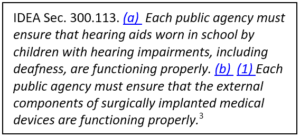 It is a cruel reality that 50% of children’s hearing aids malfunction on any given day2. In the US, IDEA specifies4 for children with IEPs, schools must ensure that the hearing devices worn by students with hearing loss are functioning. This requirement underscores the value of working hearing devices and their necessity if a student with hearing loss is to receive a free and appropriate public education, while the ADA focuses on the discriminatory nature of denying full access to classroom communication. With an effective hearing aid monitoring program in place hearing aid malfunction rates can drop to less than 1%2.
It is a cruel reality that 50% of children’s hearing aids malfunction on any given day2. In the US, IDEA specifies4 for children with IEPs, schools must ensure that the hearing devices worn by students with hearing loss are functioning. This requirement underscores the value of working hearing devices and their necessity if a student with hearing loss is to receive a free and appropriate public education, while the ADA focuses on the discriminatory nature of denying full access to classroom communication. With an effective hearing aid monitoring program in place hearing aid malfunction rates can drop to less than 1%2.
Although the law provides no specifics on who, how or how often hearing device monitoring will occur, there is clear intent that the school bears the responsibility to ensure that this monitoring occurs. This need for monitoring and data gathering was reinforced by the outcome of a 2015 court case5 that ruled that a school violated the IDEA record keeping clause (34 CFR 76.731 ) by not keeping a daily log of whether or not the student was provided daily access to the FM/DM system required by the IEP, and if the student used the FM/DM system each day.
In order to verify that the hearing device monitoring activity has occurred, the school needs to have a record of data that provides evidence of hearing device monitoring, including the daily presence and use of the FM/DM system if this communication access accommodation is included on the IEP.
What Can You/Your School District Do?
1. Include teaching hearing aid independence skills to students as a goal on the IEP or as part of ADA accommodations on the 5043 Plan. Hearing devices can malfunction at any time. ONLY the student – with training – is able to immediately identify when a problem arises, and is in the best position to troubleshoot the device and/or request assistance.6 See SEAM skill hierarchy from Building Skills for Success in the Fast-Paced Classroom or refer to Building Skills for Independence in the Mainstream for teaching independence skills6.
 2. Have administration knowledge and support of the legal requirement to perform regular monitoring and necessary data collection. Without clear support from the principal, classroom teachers often view hearing aid monitoring as a ‘good thing to do if they have time’ rather than a required activity.
2. Have administration knowledge and support of the legal requirement to perform regular monitoring and necessary data collection. Without clear support from the principal, classroom teachers often view hearing aid monitoring as a ‘good thing to do if they have time’ rather than a required activity.
3. Require that a teacher of the deaf/hard of hearing or educational audiologist meet with classroom teachers and provide instruction in how to monitor hearing device function, including involving the student in monitoring, and delineate expectations for necessary data gathering.
4. Provide clear expectations for data collection processes/forms to be used, how often data needs to be collected (i.e., daily), where it needs to be kept, and who is ultimately responsible for ensuring that monitoring and data collection occurs.
Challenge 3: Students Who Don’t Use Their Hearing Devices
While it may seem funny to turn to a child not wearing their hearing aids and say, “Your brain is in your pocket! Oh no!” it is true that about 25% of students do not (consistently) use their hearing aids7. Rejection of hearing aids can be due to lack of support from home. If the family is not supportive of the child using hearing aids, the student may feel as though they are being disloyal to what parents want by wearing their hearing aids at school. If the family does not want amplification to be used, it should not be included on the IEP and there needs to be a clear understanding of reduced academic achievement expectations and risk for social and/or behavior issues.
What Can You Do?
1. Children can often reject their hearing aids when malfunction issues frequently occur as they learn they cannot rely on hearing better via the technology8. Instruction in hearing aid use, monitoring, and troubleshooting is necessary for equal access to education6.
2. Feeling good about cool hearing aid technology is a good foundation for confidence. Items like hearing aid charms, hearing aid fairy wings, or Ear Gear ‘hearing aid outfits’ can catch the attention of peers in a positive way. With positive experiences, students with hearing loss will be better prepared emotionally to deal with the teasing that seems to be a natural part of late elementary and middle school. Share these ideas with families.

3. As students enter 3rd grade and beyond, having no preparation for resilience to teasing by peers too often results in students rejecting amplification secondary to social rejection concerns, even if they know that the amplification is important for learning. Most students with hearing loss are in their neighborhood school with no other peers who use hearing devices. Developing an identity as a person with hearing loss is not possible without feeling a part of a group of okay kids who happen to have hearing loss and use hearing devices. Connections with other students who use hearing devices, or at a minimum, viewing and discussing Kool Kidz Vidz10 can help students develop a healthier identify and resilience to being a ‘one and only’.
4. The direct involvement of a teacher of the deaf/hard of hearing to instruct students in self-advocacy skills and connect them to similar peers is needed if rejection of hearing devices due to social reasons is to be minimized.6,9 As students reach the secondary grades, they need to be fully involved in problem-solving11 their access challenges and making decisions about their use of hearing devices.
Summary
Hearing devices are the gateway to optimal school performance for students who are hard of hearing. There is both logical and legal reasons for teachers of the deaf/hard of hearing and school districts to fully support appropriate hearing device use and the skill building needed for students to feel confident when wearing their devices.
References
1. Moeller, MP, Tomblin, JB, et. al, (2015). Outcomes with Hearing Loss Study, Ear and Hearing, 36: 1S-3S, November/December.
2. Langan, L. & Blair, J.C. (2000). “Can You Hear Me?” A Longitudinal Study of Hearing Aid Monitoring in the Classroom. Journal of Educational Audiology (5), 34-36.
3. Summary of ADA information related to students with hearing loss.
4. IDEA Sec. 300.113. (a) Supporting hearing aid monitoring (b) (1) Supporting cochlear implant processor monitoring.
5. Detroit City School District., 115LRP 31115 (SEA MI 06/12/15). Written summary of court case findings.
6. Instructional materials for 43 separate goals for hearing device independence can be found in Building Skills for Independence in the Mainstream.
7. 2017 Supporting Success for Children with Hearing Loss Survey: Children Rejecting Hearing Devices: Who, Why, When? Findings for 88 respondents representing a combined caseload of 1863 students.
8. Franks, JL (2008). Why do students with hearing impairment resist wearing FM amplification? Master’s Thesis, Eastern Michigan University.
9. Building Self-Confidence & Resilience to Maximize Acceptance of Hearing Devices: Guide to Building Awareness and Skills to Facilitate Daily Use of Hearing Devices Early Childhood Through High School.
10. Kool Kidz Vidz are part of the Teacher Tools library available to members. There are 13 brief videos by students with varying degrees of hearing loss and hearing devices, including discussion questions.
11. COACH – Self-Advocacy & Transition Skills for Secondary Students who are Deaf or Hard of Hearing




